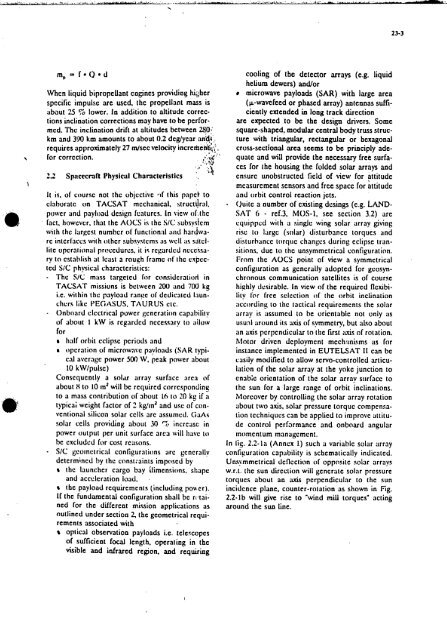0 - FTP Directory Listing - Nato
0 - FTP Directory Listing - Nato
0 - FTP Directory Listing - Nato
You also want an ePaper? Increase the reach of your titles
YUMPU automatically turns print PDFs into web optimized ePapers that Google loves.
m, = f*U*d<br />
Whcn liquid bipropellant cngines providing hi&r<br />
spccific impulse are used, thc propellant mass is<br />
:rbut 23 5 lower. In addition to altitude corrcc-<br />
tions inclination corrections may ham to be pcrfor-<br />
mcd. The inclination drift at allitudcs bctwccn BO/<br />
km and 3'90 km amounts to about 0.2 dcdycar U?$,.<br />
requires approxhntcly 27 dscc velocity incrcmcnbi,; a<br />
for corrcction.<br />
:;$:'<br />
I ;.\<br />
22 Sprtcecnft Physicul Chnmcteristics ,<br />
:.;,*.!$<br />
' .: . '<br />
It is, of coursc not the objcctivc s)f this papct to<br />
claboratc on TACSAT rncchanical, struct~ral.<br />
powcr and payload dcsign Ccaturcs. In vicw of.thc<br />
fact, however, that thc AOCS is thc S/C subsyskrn<br />
with thc largcst numbcr of funciion:rl ;itid hardwa-<br />
rc intcrfaccs with othcr subsvstcms ;is wcll ;IS siitcl-<br />
Iitc opcraiional prcxcdurcs. it is rcprtlcd ncccssa-<br />
ry to cstnhlish at least a rouyh framc of thc cxbcc-<br />
tcd SIC physical charactcristics:<br />
- Thc S/C mass targctcd Tor ccmsidcratiod in<br />
TACSAT missions is bctwccn 200 and 70(1 kg<br />
i.c. within thc payload ranpc of dcdicatcd Iiiun-<br />
-<br />
-<br />
chcrs like YEGrISUS. TAURUS etc.<br />
Onboard clcctrical powcr gcncration capabilitv<br />
of about 1 k W is rcgardcd necessary to ;daw<br />
for half orbit cclipsc pcriods and<br />
opcration of microwave pavloads (SAH typi-<br />
cal avcragc powcr 500 W. peak powcr about<br />
10 kW/pulsc)<br />
Conscqucntly a solx array surfacc ;ma of<br />
about X to 10 rn' will bc rcquircd corrcsponding<br />
to a mass contribution of about 16 to 20 kg if ;I<br />
tlTicai weight factor of 2 kgtn' and usc of convcntional<br />
silicon solar cclls arc assumed.<br />
solar cells providing about 30 '.T incrcasc in<br />
power output per unit surfacc a m will Iiavc to<br />
he cxcludcd for cost rcasons.<br />
S/C gcornctricd configurations arc gcncrallv<br />
detcrmincd by the constiaints irnposcd by<br />
thc launchcr cargo bay hncnsions. shape<br />
and acceleration load. .<br />
thc payload rcquircmcnts (including poucr).<br />
If thc fundamental configuration shall bc riqained<br />
for thc diffcrcnt mission applications as<br />
outlined under section 2, thc gcometrical requircments<br />
associated with<br />
optical observation payloads i.e. telcscopcs<br />
of sufficicnt f d length, operating in the<br />
visible and infrarcd region, and requiring<br />
cooling of the detector mays (e.g. Liquid<br />
helium dcwers) andlor<br />
microwave payloads (SAR) with large area<br />
(p,-wavefecd or phased array) antennas suffi-<br />
ciently cnended in long track direction<br />
arc cxpcctcd to be the dcsign drivers. Some<br />
squarc-shaped. modular ccntral body truss struc-<br />
ture with triangular, rectangular or hexagonal<br />
cross-scctional area seems to be principly ade-<br />
quate and will provide the necessary free surfa-<br />
ces for the housing the folded solar arrnys and<br />
cnsurc unobstructcd field of vicw for flttitudc<br />
measurcmcnt scnsors and frce spacc for attitude<br />
and orbit control rcaction jets.<br />
Ouitc 3 numbcr of clcisting dcsings (e.g. LAND-<br />
SAT 6 - ref.3, MOS-1, sec sccrion 3.2) are<br />
cquippcd with a single wing solar array giving<br />
risc to Iargc (solar) disturbancc torques and<br />
clisturbancc torque changcs during cclipsc tran-<br />
sitions. due to thc unsymmetrical configurat ion.<br />
From the AOCS point of view a symmetrical<br />
configuration as generally adopted for gcosyn-<br />
chronous communication satellites is of course<br />
highly dcsirablc. In vicw of thc rcquircd flcxibi-<br />
litv for frcc sclcction of thc orbit inclination<br />
according to thc tactical rcquircmcnts thc solar<br />
array is assumed to be oricntahic not only as<br />
usunl around its axis of spmciry, but aLco about<br />
an axis pcrpcndicular to the first iixis of rotation.<br />
hlotor drivcn dcployrncnt mcchmisrns iis for<br />
instancc implcmcntcd in EUTELSAT I1 can bc<br />
casily modificd to allow scrvo-controllcd uticu-<br />
lath of the solar array at the yokc junction to<br />
cnabk oricntation of thc solar array surfacc to<br />
thc sun for a largc rangc of orbit inclinations.<br />
Morcovcr by controlling thc solar array rotation<br />
about two axis, solar pressure torque compcnsa-<br />
tion tcchniqucs can bc applied to irnprovc attitu-<br />
dc control pcrfarmancc and onboard angular<br />
morncntum rnanagcmcnt. -<br />
In lis. 2.2-la (Annex 1) such a variable solar array<br />
configuration cap;ibility is schcmatical!y indicated.<br />
Unsymmetrical dcflcction of oppositc solar arrays<br />
w.r.1. the sun dircction will gcncrrrtc solar prcssurc<br />
torqucs about an Luris pcrpcndicular to thc sun<br />
incidcncc plmc, counter-rotation as shown in Fig.<br />
2.2-lb will give risc to "wind mill torques" acting<br />
around the sun line.<br />
23-3

















